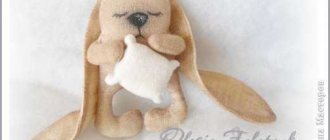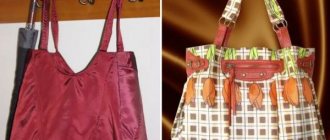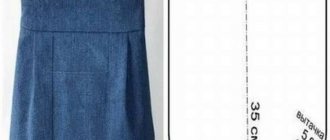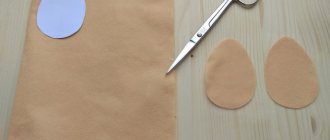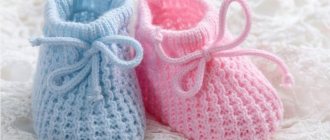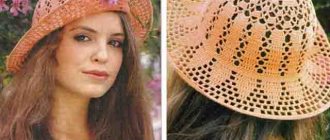This article provides a master class on how to build a pattern, pattern and sew a sweater or blouse with your own hands. You will also learn what tricks there are in these processes.
Fashion changes every season. That’s why girls always have to buy more and more new things. After all, most of them want to look modern and beautiful. In addition, clothes now play a big role in life. The first opinion of others is formed precisely by the appearance of a person. But not all beauties have the opportunity to buy the clothes they like in a fashion boutique at such high prices. But what should you do if you want this particular blouse or blouse, but don’t have the money in your wallet for it?
In this case, you can find a suitable style and sew the item yourself with your own hands. The product will fit you well, and it will be difficult to distinguish it from the original. After all, you can choose the right fabric and make a high-quality pattern according to your size. Next, we will consider in detail how to sew a blouse or blouse with your own hands without outside help.
Choosing knitted fabric for women's sweaters
When choosing a knitted fabric for sewing women's sweaters, take it into account:
- thickness;
- stretchability;
- density;
- compound.
In the table you can see what these indicators influence:
| Compound | Density | Stretchability | Thickness |
| For tailoring; cut; care; shrinkage; ability to absorb moisture. | For assortment; shrinkage; combination; selection of sewing needles. | For tailoring; cut; construction of patterns; choice of style. | Choice of threads and needles; cut; determination of seasonality. |
When choosing knitted material:
- Pay attention to the composition: a good fabric should contain 70-80% natural fibers, but sometimes you can prefer one that has a 50 to 50 ratio with synthetics.
- Check the canvas for electrification and clinging to the fingers. High-quality knitwear does not have a synthetic shine and is pleasant to the touch.
- Observe whether the material returns to its original shape after stretching.
- Hold the fabric up to the light for uneven weaves. If there are any, then the knitwear is of poor quality.
- They look at the cost. Cheap fabric, as a rule, turns out to be completely unsuitable.
High-quality knitwear will:
- pleasantly heavy;
- dense;
- drapes well;
- moderately stretchy;
- expensive.
Sweatshirts made of different materials
At the moment, sweaters for men, women and children are made from different materials. Therefore, sewing a blouse from knitwear is not difficult. Some try to combine fabrics with each other. For example, cotton is combined with openwork lace inserts, polyester is complemented by synthetics, wool is decorated with guipure and satin, and knitwear is combined with polyester. There are also more daring combinations, where sweaters are created in the style of patchwork knitting. This style involves combining pieces of different materials into one product, which you can knit yourself. The result is an authentic outfit.
Note! It is worth pointing out that the best material for a flowy hooded sweatshirt or jacket is knitwear. This is a light and breathable material for boys and girls, thanks to which you can design a jacket in different variations.
Creating a product in patchwork style
Silk, chiffon
Silk and chiffon are materials that needlewomen try not to work with when creating a jacket or sweatshirt, even for a Barbie or Monster High doll. These are the materials on which it is difficult to make drawings and patterns due to their mobility, flowability, and transparency. In addition, the difficulty of working with them lies in the visibility of needle punctures and sensitivity to water and detergents. Silk does not like washing and ironing, so if the material is wrinkled, it will be difficult to draw a drawing on it and try to connect the necessary parts together.
The finished silk product requires careful treatment and proper wear so that it does not gradually shrink and lose its shine. Therefore, creating a blouse from such material is not the best solution.
You may be interested in Patterns and sewing a sun skirt yourself
Finished silk product
Chiffon is a little more pliable than silk, but still difficult to work with. It is recommended to supplement it with other materials. For example, products with the addition of cotton fabrics, in addition to chiffon, look great.
Finished chiffon product
Knitwear
Knitwear is an excellent material for creating a light, airy and stretchy sweater, as it consists of natural yarns and silk, linen, cotton and wool threads. Often, it is created from acetate, viscose, lycra and elastane. It is distinguished by softness, hygiene, practicality, a wide variety of colors, elasticity, ease of care and breathability. It’s very easy to make a jacket out of it, based on the available master classes and step-by-step instructions.
Note! Its advantage is also that even if you make a mistake in miscalculations, the material stretches well and fits perfectly on your figure.
Knitted model
Sweater jacket
It's very easy to recut a sweater and make a cardigan out of it. This does not require darts, patterns or other drawings. All you need is to pick up scissors, needles, threads and a sewing machine. If the sweater included a neckline, then it needs to be cut off. Next, you can trim the sleeves or make interesting holes along the shoulders or back. You need to sew another material in place of the cut parts. As a rule, many people use lighter fabrics for this purpose to create a decorative sharp transition. Next, the finished product can be decorated with a belt, buttons, etc.
DIY sweater
Fabric calculation
Knitted sweaters for women are often combined or decorated with other materials. Blouses made of stretch fabric often have satin or guipure inserts. Sometimes knitwear is even combined with polyester.
With a fabric width of up to 100 cm, it is calculated for a sweater of size 48 inclusive: folded together with hem allowances for the bottom of the length of the product (2 pieces) and sleeves. If the canvas has a width of 140-150 cm, then all calculations are the same as in the first case, only the length of the product is added by one.
The length of the fabric is increased if the model has:
- larger than 48;
- complex style;
- pattern that needs to be combined;
- pockets and collar.
Chiffon blouse - MK and video
A beautiful short-sleeve chiffon blouse can be sewn using the simplest pattern. You can even call this cut option “a blouse without a complex pattern.” Chiffon is an inexpensive material (composition: viscose + polyester), just what you need for beginners and those who do not know how to cut.
These chiffon blouses have patterns from 40 to 54-56 sizes. They are all in our master class.
Now, when loose silhouettes and things without darts are in fashion, it’s time to sew fashionable blouses and dresses for yourself. You can cut on paper, or directly on fabric. All you need is a ruler and chalk.
It is more convenient to cut fabric with long scissors. Blouses with a dropped shoulder are good because you don’t need to adjust the cut of the sleeve cap to the armhole, which is difficult for beginners. This stylish chiffon blouse is available in European sizes XS, S, M, L, and XL, which corresponds to Russian size 40; 42-44; 46-48; 50-52; 54-56 clothing size.
For work we need:
- Fabric chiffon, rayon, viscose, organza - the footage depends on the width of the fabric.
- Buttons 4 pcs., diameter 1.1 cm.
- Scissors.
- Tailor's pins.
- Iron.
- For lining - non-woven fabric, you can use organza instead of non-woven fabric.
- For a machine - a thin needle number 60 or 70, stitch 1.5-2 mm.
- Pattern paper.
- Chalk or a thin piece of soap.
We bend the piece of fabric in half with the right side inward, along the lobar (look along the edge, indicated by a dash in the photo). Be careful! Lay out the pattern compactly, since we will also need to cut out the trim for the shelves and neck from the leftover fabric (arrow in the photo). Iron the fabric before cutting. Chiffon is ironed without steam, using the “silk” setting and placing gauze between the soleplate of the iron and the fabric.
So, let's start with the pattern. For size S (42-44) we make a pattern from paper:
What we see: the front part of the blouse is 2 pieces, the back is double (there should be no cut on the back), in the end the back should be 60/53 cm in size, and 2 sleeves (42/18 cm). Don't forget to add 1.5 cm to allowances everywhere. We cut out the main parts from paper, pinned the pattern to the fabric with pins, and, adding 1.5 cm, cut out all the details.
We take a centimeter and measure the size of the future facing. From the top point of the shoulder along the neckline and further to the lowest point (about 55 cm). Next, we place the already cut shelf on the rest of the fabric (front to front) and pin it to the canvas. With chalk we outline the facing, which runs along the neckline and the front edge of the blouse. The width of the facing is 7 cm, and we already know the length - about 55 cm. We cut out 2 such facings. From interlining or organza we cut the same 2 facings.
Iron the interlining with an iron, apply facings to the edges of the front edges. to the front, pin together. We sew at a distance of 0.5 cm from the edge.
Iron the facing to the wrong side of the front, leaving a 0.5 cm edge. This is what it looks like. We set the iron on “silk”.
Fold the open edge of the facing, leaving 3 cm, and iron it. It is better and safer to iron through gauze. Then we chop off the facing with pins so that it does not warp during processing. On the wrong side (along the folded facing) we make a stitch, retreating 0.5 cm from the folded edge. We do the same thing on the second shelf. We measure with chalk the places where the buttons will be sewn on and the places for the loops. We check that there is the same distance between the loops.
Then we cut out the facing for the back neckline. We place the back on the rest of the fabric and pin it with pins. We outline the upper part of the back with chalk. We cut along this line with scissors.
We fold the resulting part in half, matching the shoulder sections and measure 8 cm from the top. We cut the facing, it should be cut parallel to the neckline cut. Fold the back and facing facing right to front.
If your machine has an overlock stitch, we process the bottom of the facing with this stitch so that the fabric does not “fall off.”
Unfortunately, in most Swiss machines only have a “zigzag” line, in this case we process the cut with a “zigzag”.
Next, we chop off the top sections with pins. We sew the sections of the back neckline, stepping back from the edge by 0.5 cm. We turn the zigzag cut to the wrong side, iron it with an iron, getting a edging of 0.3-0.5 cm.
We sew the back along the front side, departing 0.5 cm from the top. We attach the back to the shelves, facing outward. On the wrong side we sew the shoulder seams, departing 1.5 cm from the edge. Iron the seam to the back and process it with a “zigzag”.
Fold the sleeve piece and make a 0.3 cm cut with scissors (marking the middle of the sleeve). We place the sleeve part face to face on our 2 parts sewn along the shoulders (back and front). Combine the shoulder seam and the middle of the sleeve. Sew on the sleeve, retreating 1.5 cm from the cut.
We work with a “zigzag” the place where the sleeves are stitched to the shelves and back. Fold, matching the side cuts and sleeve cuts. Sew 1.5 cm, starting from the bottom of the blouse and ending with the lower edge of the sleeve. We process the entire cut with a zigzag. Next, we turn the sections of the sleeves inward 2 times, pin them together and stitch along the front.
All that remains is to mark the places for the buttons and loops. We mark places for loops on the right shelf, make loops, and sew buttons. Fold the bottom 2 times, pin it and sew along the front. That's all. You sewed a blouse with your own hands without a pattern. Such models look very interesting and modern.
Patterns for sizes: 40, 46-48, 50-52, 54-56.
What do you need to sew a knitted blouse?
To work with any style of knitted sweaters, pre-prepare:
- sewing machine;
- overlock;
- pins and needles;
- soap or chalk;
- square;
- extended ruler;
- well-sharpened scissors for cutting;
- ready-made patterns.
Ready-made patterns for women's sweatshirts with a hood
A hoodie is easy to make with your sewing supplies at home. Here are the options available to work with.
How to cut knitwear?
Women can successfully create unique and original images by sewing their own clothes. For a beginning seamstress, if you have clear instructions and all the necessary tools, it will not be difficult at all to create a special item, for example, a jacket. Knitted products of simple and complex styles come out equally decent both with and without patterns.
When cutting blouses made of non-woven material, several nuances should be taken into account:
- the canvas must be cut exclusively with sharp scissors;
- patterns are taken with allowances marked on them;
- finished patterns are secured either with pins or something heavy;
- if it is necessary to fold the material in half, it is swept away not only around the perimeter, but also in other places;
- knitwear is cut lengthwise, except for the places marking the armholes and neckline.
Tips for Newbies
Many experienced needlewomen give simple recommendations to novice fashion designers on how to sew a sweater. Thus, they advise abandoning such materials as silk, guipure and chiffon at first, until the sewing technology has been mastered perfectly. They recommend giving preference to wool with the addition of polyester, since it is easiest to hide possible flaws and this model stretches well in case of failure with the size. In addition, they advise making patterns based on old things.
Open up an old piece for advice
Building a basic pattern
To create a basic pattern for a knitted sweater, take the following measurements:
- chest semicircumference (SBC);
- product length (DI);
- shoulder length (HL);
- sleeve length (SL).
Before sewing knitted sweaters for women, it is important to take measurements and make a cut.
Algorithm for creating a pattern:
- The drawing begins with the construction of the front and back parts of the product.
- Draw a rectangle on thick cardboard, where AB is pog, AC is di.
- From A, a distance equal to r/3 is retreated downwards and G is marked.
- Horizontal lines are drawn from G and G1 is marked at the intersection with the side of the rectangle.
- AB is divided by 3 and marked A1 and B1.
- From them to GG1, vertical straight lines are drawn, obtaining G2 and G3 at the intersection.
- GG1 is divided in half and G4 is placed.
- From it they go down to the CD, drawing a vertical line. At the place of suppression they receive C1.
- For the armhole, bisectors with lengths of 2 and 1.5 cm are drawn from the corners G2 and G3, thereby obtaining G5 and G6.
- A1, G5, G4, G6 and B1 are connected using a smooth line.
- For the neck, a distance equal to dp is retreated from A1 to the left, A2 is marked.
- From A downwards put 2 cm and get A3.
- A2 and A3 are connected by a sliding line.
- On the front part, step back from B1 to the right, marking B2, and from B - 5-6 cm down, getting B3. The resulting points are smoothly connected.
- Everything unnecessary is erased.
Construction of a drawing for a set-in sleeve of a sweater:
- Build a rectangle with sides AB = linear/3 t AC = other.
- To obtain point O, descend from A to a distance equal to half a linear distance.
- A parallel AB is drawn from it. The intersection with BD is marked as O2.
- The resulting rectangle is divided by lines into 4 equal parts.
- The top and bottom vertices of half the rectangle are marked as B1 and B2.
- Points O2, B1 and B1, O are connected.
- A straight line is drawn from B1 downwards and the intersection with CD is marked as B3.
- To obtain B4 and B5, a distance equal to half the semicircle of the hand is retreated in 2 directions from B3.
- Next, according to the drawing, the details are shaped, after which the extra lines are erased.
- If the hips and chest are very different in size, then the bottom of the product is widened by the difference between them.
How to sew a children's blouse
Children's sweaters and blouses are best made from natural fabric (cotton, flannel) or light knitwear.
Such fabrics are an excellent solution for children's clothing. The pattern of the model you like needs to be printed and cut out. After this, you should transfer the details to the material.
The work is performed in the same way as when sewing products for adults. The front and back are sewn along the side seams; they should be ironed onto the back. Leave 1.5 cm for allowances. Various applications can be applied to the finished item.
What is the name of a short jacket with long sleeves?
How to knit a sweater
Using ready-made patterns
The finished patterns are laid on the fabric and secured until immobile.
The image is outlined with tailor's chalk or a bar of soap, taking into account allowances for hems and seams. Next, all parts are cut out and basted. After fitting, the parts are machine stitched. If there is a collar, then 2 additional fabric strips with a width of 2.5 cm are prepared for it. They must be cut on the bias. At the very end, sleeves are sewn in, complemented by cuffs.
Knitted dress
Knitwear is perfect for this option. In order to make the top blank, you can use a comfortable loose T-shirt. The skirt is taken to the bottom.
Thus, carefully place the T-shirt on the folded fabric and combine it with the skirt. Make notes. Don't forget to leave 0.5-1 cm for allowances.
Now you need to cut and sweep the blank, sew all the seams (shoulders and sides) and a simple dress without a pattern is ready.
Note!
- Knitted raglan - step-by-step instructions, patterns, recommendations. Photo review of the best works and new products from craftswomen
Knitting a shawl - step-by-step instructions for making a shawl with your own hands. Tips for beginners on knitting + photo reviews
Amigurumi ring ⭕: features of the amigurumi technique. Step-by-step DIY master class with simple knitting patterns + 180 photos
Old T-shirt as a pattern
Knitted sweaters for women are easy to design and sew. Having learned this, you can easily create various models for further combination with other clothes. The principles of making blouses from soft stretchable fabric are quite simple and understandable.
To sew a knitted sweater, a used T-shirt can serve as a base.
It is ripped open or circled whole. A T-shirt disassembled into parts will suit complex styles, and an ordinary one will suit simple ones. But with such an alternative pattern, the neckline of the future sweater is increased on the chest.
Dress with straps without a pattern
For this model you will need a wide piece of fabric of any color.
- It is better to choose a material that is pleasant to the touch and elastic.
- The length of the future product is chosen as desired, but the width should be such that the fabric can easily wrap around the body twice. Production time 15-20 minutes.
- Straps are sewn onto the corners of the fabric. Thin straps look beautiful.
- The dress turned out completely without seams. It is advisable to process the edges of the material.
- Additionally, the item can be decorated with a brooch or other decor.
You can wear this model to the beach or for a walk on a hot day, or use it at home.
Setting up a sewing machine, installing a needle for knitwear
Before sewing a knitted product, set a stitch with a length of 2 mm on the machine and check the stitching on the flaps. In this case, you should also choose a needle with a rounded end.
Such a device will pass between the knitted fibers, correctly forming loops.
Materials and tools
Before starting work, you need to prepare all the necessary tools. To create a knitted suit you will need:
- patterns;
- scissors;
- threads;
- soap;
- rubber;
- measuring tape;
- suitable fabric;
- decorative elements to taste.
To make a high-quality knitted suit, it is not enough to have one sewing machine. It is advisable to use a chain stitch device in your work. The equipment allows you to make the reverse sides of the seams smooth. An overlocker is indispensable when sewing suits from stretchy thin materials; it quickly makes a zigzag. Finished seams are elastic and have no ties or skipped stitches.
You should definitely replace the needles on your machine. Products with rounded ends that will fit between the fibers without damaging them are suitable. There are tools designed specifically for a certain type of material: jersey - for wool and cotton knitwear, stretch - for synthetics or fabrics containing lycra.
Features of working with knitwear. Useful sewing tips
Beginner seamstresses are recommended to begin their sewing work with basting. Machine processing of parts begins only after careful fitting of the temporarily hand-sewn product. With this approach, the risk of size errors is significantly reduced.
When processing the edges and neckline, the use of bias tape is allowed. For sweaters with an ethnic flavor, choose satin ribbons in rich colors or with ornaments. A product with a similar design acquires freshness and originality.
To prevent a knitted sweater from becoming too tight, the stitches are made with a margin. Be sure to try to make sure that the machine stitch matches the basted seam. The thread tension when sewing should be moderate (about 5). Suitable seam variations are selected by testing on scraps or scraps of fabric.
To maintain the elasticity of the knitwear, the cut parts of the future product are stitched with a narrow zigzag stitch with a width of up to 1 mm and a length of 3 mm. It is advisable to sweep away the details using thin threads. To finish the shoulder seams from the inside of the product, use bias tape or tape - this way they will not stretch. Seam allowances are sewn with an overlocker or a large zigzag stitch. For the same purpose, the lower hems are not done too tightly by hand.
To sew your first items yourself, choose light styles without:
- a large number of parts;
- unnecessary layers;
- folds
When the machine skips stitches under the knitted fabric when sewing, place thin paper, such as newspaper or wrapping paper. Fabrics with weak elasticity are slightly stretched when stitching. For crooked or gathered machine stitches, loosen the presser foot so that it puts less pressure on the fabric. To avoid pulled seams, the threads on the bobbin are wound slowly. Very thin knitwear is laid underneath with newspaper layers to give it the missing thickness.
Knitted sweaters for women have many styles and creation methods. Clothing made from tight-fitting fabric does not require ironing and fits even the fat ones. Blouses with excellent thermoregulation are worn in any season.
The details of the sliding knitwear, before placing them under the machine, are first sewn to each other by hand. It is very important to remember when working with knitwear that basting always goes in one direction, and subsequent sewing - in the opposite direction. With this technique, the displacement of parts is completely blocked.
An adhesive pad that saves knitwear from stretching when sewing is used for:
- neck;
- pockets;
- cuffs;
- below.
Starch or flour paste can also save the canvas from stretching. This sticky solution is used to treat the edges of the product before sewing. The finished item is subsequently washed to remove it from the fabric.
Instead of using paste under the knitwear, you can put:
- toilet or wrapping paper;
- paper towel;
- napkins.
The hems are sewn together with an overcast stitch.
The following machine stitches are suitable for working with knitwear:
- knitted;
- double;
- flat;
- zigzag;
- overcast;
- stretch;
- straight;
- universal.
Special Jersey needles are used for natural and dense fabric, and Stretch for thin fabric mixed with viscose.
Superstretch needles are suitable for working with:
- micro oil;
- lycra;
- biflex.
It is convenient to stitch and hem with a double needle:
- bottom of the product;
- armholes and sleeves;
- neck;
- collar stands;
- cuffs
Flowy fabric dress
Prepare the fabric. Its size depends on your height and build. Therefore, it is necessary to measure the desired height. It is measured from the armpit to wherever you want (above, below the knee). And the width should be such that you can wrap the fabric 2 times.
The fabric for this product is selected to be light, flowing, it is better that it stretches. You should not use cotton fabric.
Thus, it turns out to quickly sew a dress without a pattern. Finish all edges of the product and, if desired, overlay with a seam. Thin straps are sewn onto 2 corners.
The whole dress is ready, all you have to do is wrap it around it and you can go to the beach.
First, the first strap is put on, then the dress is wrapped around the body and the second strap is put on. If desired, you can add a beautiful belt.
Master classes on self-tailoring sweaters for women with and without patterns
Presentations teach beginners how to sew any styles of knitted sweaters.
Off the shoulder style
A dropped shoulder on the product can replace short sleeves.
It also hides the fullness of the shoulders. Sleeveless models or patterns are taken as the basis for the manufacture of such a sweater. Lines on the sides and shoulder lengthen both the front and back of the product. The pieces joined together will subsequently create a new shoulder length. After cutting, the cut out parts of the jacket are ground to 3 cm in width at the neckline and armhole.
Short sleeve style with guipure
A summer version of a blouse with short sleeves made of fine wool and with a guipure insert is made as follows:
- They take measurements.
- Drawing a pattern.
- The upper part of the base to the level of the beginning of the chest will be intended for guipure insert, and the rest of the lower part will be for knitwear.
- When transferring the pattern onto the fabric, allowances for freedom of movement (10 cm) and for seams are taken into account.
- After preliminary overcasting, the cut out parts are sewn together on a typewriter.
Long sleeve style with buttons
For a sweater with long sleeves with buttons, the pattern differs in that the front part of such a product consists of 2 shelves. Additional details also include strips of fabric allocated for fastening strips. Sleeves can be one-piece or raglan.
If there is no pattern, then knitted items can be sewn without one by following the pattern according to the measurements taken directly on the fabric. One-piece sleeves are drawn together with the front, smoothly connecting the sides of the jacket with the bottom line of the part (sleeve).
Zip style
A model of a sweater with a zipper is made similar to a product with buttons, but instead of them, a fastener is sewn into the edges of the front shelves. The zipper can be the length of the entire product or only reach half of it.
Model with lace
A ready-made knitted sweater is often combined with lace. Inserts are made from it, which are sewn overlapping onto the knitted product.
Lace appliques on sweaters are found:
- ahead;
- behind;
- On the sides.
Model with lurex
Knitwear with lurex when making blouses from it does not require too large seam allowances and free movement. This material is cut without backing, directly on the fabric. To prevent it from slipping, it is spread not on bare surfaces, but on lined sheets, for example. The edges of knitwear with lurex must be machine stitched in a zigzag pattern so that they do not fray later.
Knitted sweaters for women can be sewn even without a pattern, using, for example, an old product as a basis. This technique will be especially useful for beginners who are encountering modeling for the first time. For the same purposes, ready-made patterns are used.
Algorithm for sewing a bat-shaped sweater from knitwear with lurex:
- They take measurements.
- The fabric is folded in half so that its wrong side is on top.
- For the neckline, set aside 3 cm from the fold downwards, and 9 cm to the side.
- The shoulder and sleeve lengths are set aside from the neckline.
- The waist and hip circumferences are divided into 4 and also plotted along their lines.
- The bottom of the model and the edge of the sleeve are smoothly connected.
- All lined parts of the product are cut out and sewn.
Sweater jacket
You can easily make a new sweater out of an old sweater.
For this:
- cut off and remake the neck;
- cutouts are made on the sleeves or shortened to a length of ¾;
- sew the product on the sides to achieve a fitted silhouette;
- parts made from other materials are inserted instead of the cut parts.
Shirt dress
Prepare a shirt (preferably 2-3 sizes larger). A master class on how to make a dress without a pattern will help you update and diversify your wardrobe.
Let's consider as many as 2 options for making simple dresses from an ordinary men's shirt. These options are distinguished by their ease of manufacture.
Doesn't require much effort. No patterns are used. All you need is patience and maximum imagination.
Choose products made from cotton or linen fabric.
In order not to do unnecessary manipulations, it is better to purchase shirts made of dense and non-transparent material.
Dresses can be decorated to suit every taste. For example, sew on beads or rhinestones, or maybe you decide to hang a beautiful new brooch; embroidery elements will also look beautiful.
How to decorate the finished product?
It is advisable to think through the decor for clothes in advance, even before the item is created.
Finished knitwear products are usually decorated with:
- crocheted flowers;
- fur or leather appliqués;
- rhinestones;
- sequins;
- beads;
- hand embroidery from floss.
Making knitwear yourself is not a difficult task. With the help of a sewing machine and tailoring skills, it will not be difficult for a woman to replenish her wardrobe with original and stylish sweaters.



